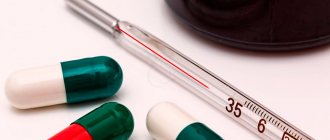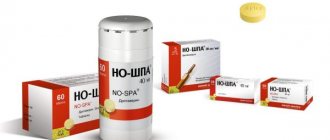If a child has a temperature of 37, then caring parents immediately put him on bed rest and provide him with everything necessary to avoid the development of the disease. An elevated thermometer indicates that the immune system is fighting against agents that have entered the body, and this process is often resolved in its favor. But this takes time, that is, several days, which should show how strong the child’s immunity is or whether he will need help from medications. Children often suffer from colds, flu or ARVI, which are accompanied by fever. But sometimes fever can appear on its own, without accompanying symptoms. And if the indicator 39°C really worries parents, then a large number of questions arise even if the child has a temperature of 37°C. How to deal with such a temperature, what can it indicate and how should parents behave in this situation?
Low-grade fever and accompanying symptoms
The causes of low-grade fever can be various diseases and they can be found out even before the doctor arrives based on certain symptoms. So, the temperature is 37 and...
• diarrhea. Such symptoms may indicate the presence of helminthic infestation or intestinal infection; • runny nose. There is a possibility of developing a cold or allergy; • abdominal pain. Symptoms of diseases such as measles, food poisoning, whooping cough, acute respiratory infections, appendicitis; • cough. Symptoms of the initial stage of bronchitis, colds, pneumonia, chronic tonsillitis, tuberculosis; • headache. Such symptoms are usually present with influenza, sinusitis, ARVI, thermoneurosis, intoxication, meningitis; • lethargy. Symptoms of the onset of an infectious disease, oncology, helminthic infestation; • hoarseness of voice. Symptoms are typical of flu, tonsillitis, laryngitis, diphtheria, • asthma, pneumonia.
Sometimes a temperature of 37°C can persist in children even after taking a course of antibiotics. At first glance, the child became active after the illness, he developed an appetite, and began to play with toys with interest. But after measuring the body temperature, that hated figure of 37°C appears on the thermometer again. What to do in such a situation? The first thing to do is to show the child to a doctor who will conduct a control examination. And if no pathological changes are detected, then no additional treatment is required.
If the temperature is accompanied by a cough, runny nose, and the child again becomes lethargic, then, most likely, there will be a suspicion of a relapse or a new infection. After the examination, the doctor himself will develop a treatment regimen and prescribe new medications.
Age-related physiology and temperature 37°C
Age-related physiology can affect body temperature. • in newborns, the norm is 37°C. Most often this applies to premature babies with an immature thermoregulation system. • 1 month after birth. A temperature of 37°C can persist after vaccination against viral hepatitis. • 2 months. Low-grade fever after vaccination against pneumococcal infection. • 3-4 months from birth. The temperature is kept within 37°C as a result of vaccination against diphtheria and pneumococcal infection. • 5 months from birth. If a low-grade fever is accompanied by colic, bloating, increased flatulence or constipation, this may indicate a reaction after the introduction of protein complementary foods. • 6-7 months. During this period, children usually teethe, the process of which often causes a slight increase in body temperature, which can last for a week.
Infectious causes of temperature 37-37.9℃
Long-term persistence of values of 37.2 and close to it often indicates the presence of latent focal inflammation or infection. Features of low-grade fever of microbial origin:
- diurnal changes are well expressed, for example, 37.1 in the morning, 37.9 in the evening;
- the child’s well-being noticeably deteriorates,
- easily knocked down by antipyretics.
Usually the temperature is not brought down to 38.5, but there are many exceptions to this rule: nervous and other chronic diseases, a tendency to seizures.
Not only the thermometer readings, but also the deterioration of the child’s general condition and other alarming signs should be the “bells” that cause concern and understanding that this is a disease that requires seeing a doctor.
Sometimes fever persists for up to two months after influenza and ARVI. This phenomenon is called a temperature tail. If with such hyperthermia the blood and urine tests are normal, then it does not require special treatment and gradually goes away on its own.
Rules of conduct for parents
What to do if your baby has a temperature of 37°C? If the reading of 37°C is not accompanied by symptoms that may raise suspicion of the development of the diseases described above, then you should adhere to the position of wait and watch, but not more than 1 week. Regardless of whether additional symptoms appear or not, after a week parents are required to take the following measures:
1. Determine the clinical picture, that is, all kinds of deviations. 2. If the child’s well-being worsens, immediately call an ambulance. 3. Give the child plenty of warm drinks, but giving antipyretic drugs is strictly prohibited. 4. Provide fresh air and normal humidity levels in the room. 5. Take your baby for a walk more often. 6. Ensure a normal psychological environment. 7. Organize proper and balanced nutrition. 8. If the child’s condition does not improve and the temperature continues to persist, then make an appointment with a doctor.
The clinic will conduct the necessary examination, on the basis of which the doctor can make the correct diagnosis and answer the question: why does the baby have a low-grade fever.
If not an infection
A temperature of 37.1 or higher can last a month or longer for many diseases in children that are not associated with germs. Here is an approximate list of them:
- autoimmune diseases, in which one’s own tissues and organs are perceived by the immune system as foreign: rheumatoid arthritis,
- type 1 diabetes mellitus,
- systemic lupus erythematosus,
- autoimmune thyroiditis and hepatitis,
Features of temperature in non-infectious diseases:
- fluctuations during the day are weakly expressed or are disrupted from the pattern. For example, in the evening it is lower than in the morning,
- is not affected by antipyretics.
Low-grade fever may have a psychogenic origin, that is, associated with the characteristics of the nervous system and the conditions of the child’s social life. Temperatures from 37.1 to 37.6 for no apparent reason occur in children, who are characterized by:
- unsociability;
- irritability;
- isolation;
- suspiciousness.
Such a child must be treated with care and caution so as not to traumatize his fragile psyche. Long-term hyperthermia can be caused by fear, despair, longing for loved ones, anticipation of something important, any strong emotions or significant events, even positive ones.
Long-term neurogenic fever can occur in diseases of the nervous system, medicinal fever - due to prolonged use of certain drugs, post-traumatic fever after operations and severe injuries.
A special case is constitutional or growth subfebrile condition. This is when a child, during periods of active growth and feeling well, has a temperature rise to 37.3, sometimes higher. It lasts up to 3-4 months, and then returns to normal on its own.
Preventive measures
Even if, after examination, no pathological changes are revealed in the baby, and the doctor insists that this indicator is normal for your child, you should not remove the issue of low-grade fever in your child from the agenda.
You need to understand that such a temperature over a long period of time can cause harm to the child. Therefore, you must do everything in your power to stabilize the situation. It largely depends on parents: • timely treatment of any disease, • limiting children from stressful situations, • maintaining the correct daily and sleep schedule. • hardening procedures, • child's attendance at sports clubs, • frequent walks and sunbathing. The above preventive measures will help the child’s body strengthen the immune system and stabilize the process of thermoregulation. Correct adherence to all recommendations will allow parents to quickly cope with the problem, bring the child’s body back to normal and overcome low-grade fever.
How to measure correctly?
A child under 1 year of age produces 2.5 times more heat per kilogram of weight than his parents. For an adult, the thermoneutral zone, that is, a comfortable temperature with a naked body, is 27-29℃, and for an extremely lightly dressed child aged 1 year, 18-22℃. Therefore, babies easily overheat. And if every time you measure the temperature in a room with warm, dry air in a thoroughly dressed baby, you can get the illusion that the temperature of 37-37.5 does not decrease - even for a month, even for a year.
To identify the real picture, you need to place a thermometer in the morning, afternoon and evening for 14 days in a row. Record the results every time. Monitor other symptoms closely. And then consult a doctor with this information.
The pediatrician should give a referral for urine and blood tests, possibly stool, and mucosal swabs. And only after this will it be possible to determine the exact cause of prolonged low-grade fever with “fuzzy” symptoms.
But this does not mean that the baby should not be given any help until the diagnosis is made. At a temperature of 37 to 37.9, if it lasts a month or longer, there is a danger of dehydration and depletion of defenses. Therefore, it is necessary to create conditions under which this test of immunity will be more easily tolerated:
- be in the fresh air, the younger the child, the more often;
- provide nutrition rich in vitamins and microelements;
- give warm drinks often;
- create favorable conditions in a room with a temperature of 18-22℃ and a humidity of 45-70%.
What is low-grade fever? It's not a fever, but it's not normal either. Sometimes mothers worry: the child has a fever, what to do? Let's consider the question of why the temperature can stay at a certain level for a long time and not subside.
What should your baby's temperature be?
The body temperature of a healthy person is not a constant value. Indicators may vary depending on what room the child is in and how he is dressed. It is generally accepted that a normal body temperature is 36.6 degrees. Minor deviations are allowed. A reading below 35.5 degrees or above 37.0 degrees is considered abnormal. Increased body temperature can be subfebrile (up to 38.0 degrees) and febrile (over 38.0 degrees). Often, even a temperature of 37.5 in a 2-year-old child is not considered pathological. This may be a normal option if nothing bothers the baby, he is not capricious and eats well.
It is important for parents to learn how to correctly measure their child’s body temperature. Errors can lead to the thermometer displaying values that do not correspond to reality. Particular attention should be paid to the procedure for measuring temperature if the child does not have concomitant symptoms of the disease (he does not cough or is capricious).
Under no circumstances should you begin the procedure after the child screams or cries. Any physical activity can cause an increase in performance. You cannot take measurements after an active walk. Immediately after waking up, the baby will experience, on the contrary, a decrease in body temperature. It is advisable to carry out measurements in a quiet environment. The armpit should be completely dry. Often a temperature of 37.2 in a 2-year-old child is the result of exposure to moisture.
Many people today use electronic thermometers. It has been noticed that such devices do not always show accurate data. It is worth giving preference to proven mercury thermometers.
Oral measurements often give increased body temperature readings. In addition, this technique cannot be called hygienic.
You cannot measure a baby's temperature:
- after meal;
- after a walk;
- after crying;
- After sleep;
- after swimming;
The temperature of a child under one year old is measured in different ways: in the armpit (normal is 36-37 degrees), in the inguinal fold, orally (normal is 36.9-37.4 degrees) and rectally (normal is 36.6-37.3 degrees). It is best to do this every day at the same time, when the baby is calm.
But, despite all of the above, the temperature of a child up to one year old needs to be monitored, because an elevated temperature can also indicate illness. If the baby is breathing heavily, is capricious and cries a lot, or, on the contrary, is very lethargic, refuses to eat, or shows signs of a cold, then it is unacceptable to ignore the fact that the child’s temperature is rising.
At a temperature of 38 and above, you should immediately call a doctor, since it is very difficult to independently determine the cause of a high temperature in a baby.
Help a child
What to do and how to help the baby get better? First, you need to choose the right drug to reduce fever. Secondly, do not give your child antipyretics for the sake of prevention. If the baby tolerates the heat normally, then you should not knock him down. The child’s behavior is an important guideline for solving this problem.
When it is hot, you should offer your child regular water more often to prevent dehydration. This is a very dangerous condition for a child’s body, especially if hyperthermia is accompanied by diarrhea and vomiting. A small baby can be fed from a spoon if he refuses to suck the pacifier. Don't let your baby's lips dry out.
Changing the humidity in the room will help alleviate the child's condition. If you don't have a humidifier, you can simply hang clean, wet towels. The room should be warm, but not hot. Do not wrap your child in warm clothes so as not to increase the fever even more.
Many mothers begin to worry about their baby’s lack of appetite. However, this is a normal state during illness: the body spends all its energy fighting negative agents. The appetite will return as you recover, and the baby will gain weight again.
To avoid overcooling your child at night, do not be lazy to replace wet underwear with dry ones. At night, the body actively rids itself of toxins, and the child sweats profusely. It is wet underwear that can cause complications after an illness or cause a recurrence of the disease.
Children are sensitive to any changes in the body, especially to the penetration of infection. An increase in temperature always indicates an active reaction of the immune system to foreign agents - protein structures. If the temperature lasts for three days without exceeding 38.5, it means that the child’s immune status is in an active form. The thermometer at 39 indicates the body’s inability to cope with the infection on its own, so it is necessary to take antipyretic medications.
Increased body temperature in an infant is not a disease in itself, it is only a symptom of the disease. Acute bacterial and viral infections are common causes of fever in newborns. Also, the temperature can jump due to overheating, emotional stress, dehydration, a reaction to vaccination, teething, or damage to the central nervous system.
It is known that at temperatures up to 39 ° C, almost all known viruses and bacteria die, contaminating the body. In this case, intoxication appears and, as a result, the temperature increases, which activates the immune system.










